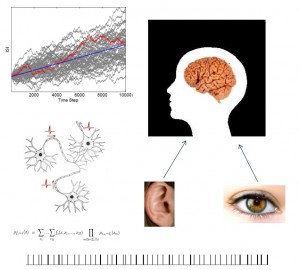 Date: 05 December 2012
Date: 05 December 2012
Time: 13.00-14.00
Place: tba
The information interaction in biological nervous system sprits a living body. Sensory neurons encode the spatiotemporal information of a stimulus into a sequential spike train. Any neural spike carries Inter-Spike-Interval (ISI) timing information as a message and a statistical inference of the ISI along a temporal window is assumed as a perception. When a sensor is missed, the spike generation is predicted through the prior perception and the uncertainty of this perception has to be increased. Multimodal sensory fusion improves the perception by decreasing the uncertainty and its combination with prediction improves the perception psychophysically. The Belief Propagation (BP) algorithm is used to perform sensory message passing in a spiking network. The last messages from asynchronous spikes of different modalities are preserved to make an association in a memory. A stationary perception is constructed by the memorized messages along a missing sense but the perception has to be dynamic to predict spatiotemporal information of a dynamic stimulus psychophysically. In this research we investigate the sensory perception through a stimulated spiking visual sensor and address the attenuation of preserved information by the drift-diffusion phenomenon for a dynamic perception. We experiment the variation of statistical features optimizes the spiking network in multimodal sensory perception over time and space.